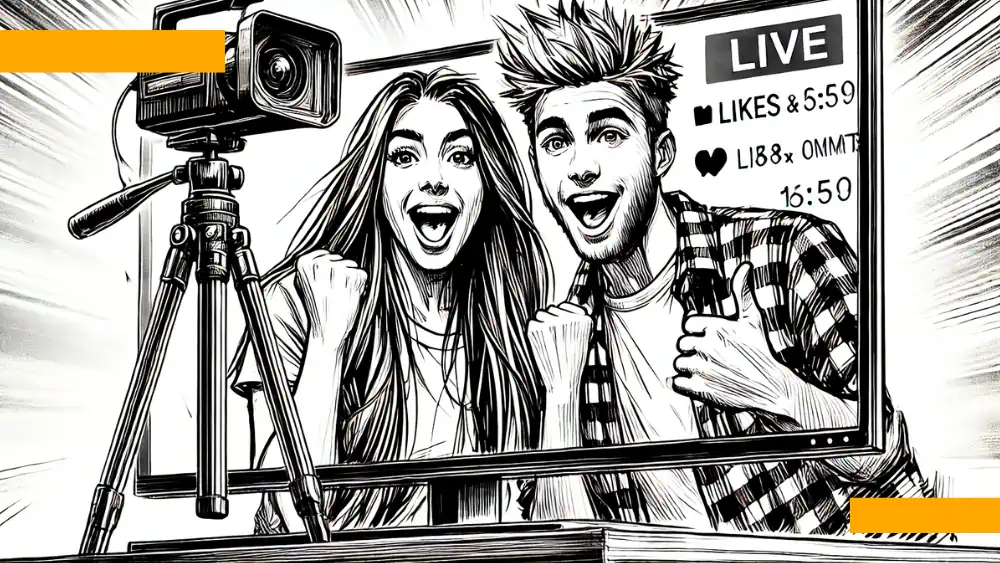 illustration: DALL-E
illustration: DALL-EAs highlighted by the authors of the "Behind The Screens" report, published at the end of 2024 by UNESCO, digital creators operate for various reasons. Most frequently, they emphasize sharing knowledge (26%), earning income (23.8%), and providing entertainment (23.4%). Less common motivations include expressing opinions (13.8%) or promoting specific causes (5.8%).
For instance, Amanda da Cruz Costa from Brazil emphasizes her engagement in climate activism, while Faith Sycaoyao from the USA sees her mission as inspiring others through art. Creators, despite working in different fields, combine personal passions with a mission to influence the world.
Main Motivations:
- Sharing knowledge: 26%
- Earning income: 23.8%
- Entertainment: 23.4%
- Expressing opinions: 13.8%
- Promoting causes: 5.8%
Content Credibility Issues
A significant portion of creators (62%) admit that they do not thoroughly verify information before publishing. Popularity – measured by likes and views – is their main indicator of credibility (41.7%). Further down the list are recommendations from friends (20.6%) and evidence in the content (17%).
| Indicator | Percentage of Creators |
|---|---|
| Popularity (likes, views) | 41.7% |
| Recommendations from friends | 20.6% |
| Author’s reputation | 19.4% |
| Evidence and documentation | 17% |
The lack of systematic data verification poses risks to content audiences. UNESCO recommends intensifying training for creators to promote better media practices.
Law, Ethics, and Hate Speech
The study reveals that 59% of creators are unaware of regulations regarding freedom of speech or copyright laws. Only 32.4% of respondents claimed a good understanding of these regulations.
Insufficient legal knowledge is also linked to ethical issues. Only 50% of creators always disclose their content sponsors, undermining the transparency of their actions. This points to the need for implementing ethical standards in the influencer industry.
One of the biggest challenges for creators is hate speech. As many as 32.3% of respondents have experienced it firsthand, with 31.5% ignoring such incidents and only 20.4% reporting them to platforms.
Creators and Social Media Platforms
The relationship between creators and platforms is crucial for their success. The report indicates that 67.8% of respondents find platform guidelines clear, although most believe that technical support could be improved.
| Aspect | Percentage of Respondents |
|---|---|
| Clarity of guidelines | 67.8% |
| Content moderation | 64.6% |
| Technical support | 65.9% |
| Safety management | 69.3% |
Introducing better algorithms and a more human approach to moderation could improve the quality of collaboration between creators and platforms.
Training and Support
The report highlights a significant demand for training. Only 13.9% of respondents have participated in any ethics or legal courses, although 73.7% expressed interest in free UNESCO programs.
What Can Help Creators?
- Access to training in ethics and law.
- Tools to combat hate speech.
- Better collaboration with social media platforms.
Implementing such initiatives would allow creators to operate more responsibly and professionally. The UNESCO report shows that digital creators play a key role in shaping public opinion and promoting credible content. However, for their influence to be positive, they need support through training, regulations, and better relations with platforms.
The research was conducted on a group of 500 creators from 45 countries and included 20 in-depth interviews. The full UNESCO "Behind The Screens" report is available for free at https://news.un.org/en/story/2024/11/1157546.
COMMERCIAL BREAK
New articles in section Media industry
Advertising market 2025. Poland, Europe and the World
Marcin Grządka
The global advertising market is growing by 8.8% in 2025 and will reach a value of 1.14 trillion dollars. The industry result in Europe records slightly lower dynamics, at the level of 5.8%. In this comparison, Poland performs clearly above the average. We will record an increase of 8.9% this year and a value of 18.56 billion PLN - estimates WPP Media in the annual report "This Year Next Year".
The print media market 2025. Three global trends
Krzysztof Fiedorek
The market value is 359.53 billion dollars, yet the erosion is visible to the naked eye. The decline for newspapers will amount to -2.3 percent. Despite this, print retains strength: it generates 76 percent of subscription revenues and enjoys 82 percent consumer trust. The future of the industry is defined by hybrid strategies and niche specialization.
Journalism in the age of AI. Why people prefer humans over machines
Krzysztof Fiedorek
Only 12% of people accept news created solely by AI, while 62% prefer those written by humans. At the same time, only 19% notice labels indicating the use of artificial intelligence, while younger audiences ask AI to explain the content to them. These are the findings of the Reuters Institute report on artificial intelligence in media.
See articles on a similar topic:
Streaming Services. Rapid Growth of Subscribers in Poland
RINF
Compared to 2020, 20% more Poles declared having a subscription to video streaming services in 2021, according to the *Digital Consumer Trends 2021* report published by Deloitte.
Influencers 2024. Data, Facts, and Stories from the UNESCO Report
Krzysztof Fiedorek
As many as 68% of digital creators are nano-influencers. One in three has experienced hate speech, and over 60% do not thoroughly verify information before publishing. Moreover, only half disclose their content sponsors. The findings from the "Behind The Screens" report are both inspiring and alarming.
E-commerce Forecasts in Poland. Trends for 2024 and Beyond
Krzysztof Fiedorek
In 2024, e-commerce in Poland is reaching new heights, with an increasing number of consumers regularly shopping online. The report "E-shopping Habits of Poles 2024," prepared by SAMOSEO analysts, analyzes current trends and forecasts the industry's near future.
Influencers and social video rule information. Digital News Report 2025
Krzysztof Fiedorek
Seconds of vertical clips set the future of news. TikTok, YouTube and an army of influencers pull viewers away from TV sets and newspaper pages. Whoever masters this new pulse seizes not only attention but also control of the story.





























